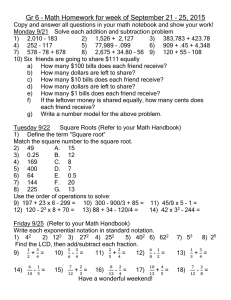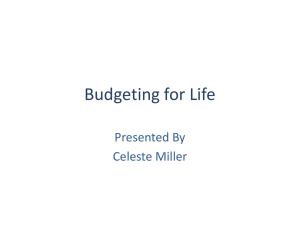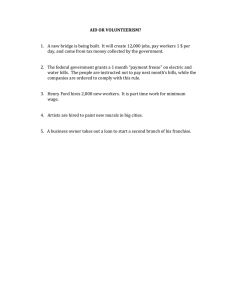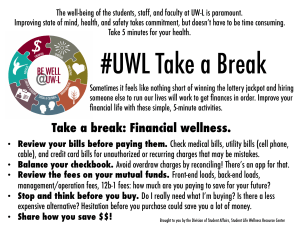Sharing Money - Everyday Math
advertisement
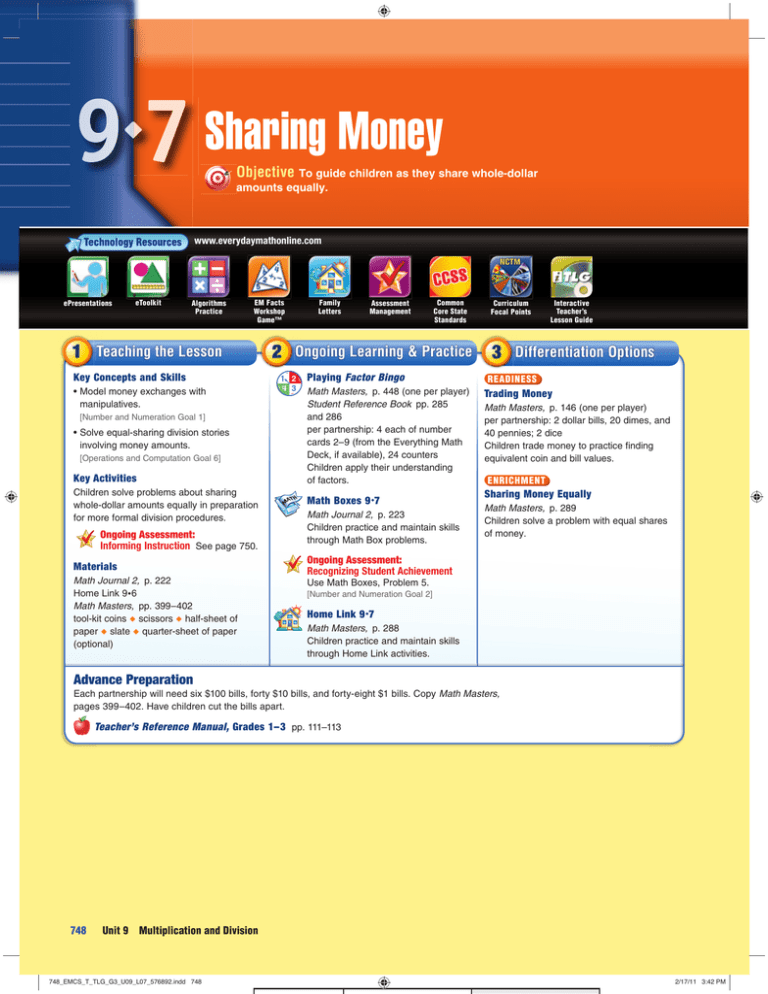
Sharing Money Objective To guide children as they share whole-dollar amounts equally. a www.everydaymathonline.com ePresentations eToolkit Algorithms Practice EM Facts Workshop Game™ Teaching the Lesson Key Concepts and Skills • Model money exchanges with manipulatives. [Number and Numeration Goal 1] • Solve equal-sharing division stories involving money amounts. [Operations and Computation Goal 6] Key Activities Children solve problems about sharing whole-dollar amounts equally in preparation for more formal division procedures. Ongoing Assessment: Informing Instruction See page 750. Materials Math Journal 2, p. 222 Home Link 9 6 Math Masters, pp. 399 – 402 tool-kit coins scissors half-sheet of paper slate quarter-sheet of paper (optional) Family Letters Assessment Management Common Core State Standards Curriculum Focal Points Ongoing Learning & Practice 1 2 4 3 Playing Factor Bingo Math Masters, p. 448 (one per player) Student Reference Book pp. 285 and 286 per partnership: 4 each of number cards 2– 9 (from the Everything Math Deck, if available), 24 counters Children apply their understanding of factors. Math Boxes 9 7 Math Journal 2, p. 223 Children practice and maintain skills through Math Box problems. Interactive Teacher’s Lesson Guide Differentiation Options READINESS Trading Money Math Masters, p. 146 (one per player) per partnership: 2 dollar bills, 20 dimes, and 40 pennies; 2 dice Children trade money to practice finding equivalent coin and bill values. ENRICHMENT Sharing Money Equally Math Masters, p. 289 Children solve a problem with equal shares of money. Ongoing Assessment: Recognizing Student Achievement Use Math Boxes, Problem 5. [Number and Numeration Goal 2] Home Link 9 7 Math Masters, p. 288 Children practice and maintain skills through Home Link activities. Advance Preparation Each partnership will need six $100 bills, forty $10 bills, and forty-eight $1 bills. Copy Math Masters, pages 399– 402. Have children cut the bills apart. Teacher’s Reference Manual, Grades 1– 3 pp. 111–113 748 Unit 9 Multiplication and Division 748_EMCS_T_TLG_G3_U09_L07_576892.indd 748 2/17/11 3:42 PM Getting Started Mental Math and Reflexes Math Message What is each person’s share if $1 is shared equally among 5 people? 20¢ If $2 is shared equally among 4 people? 50¢ $3 among 6 people? 50¢ $2 among 5 people? 40¢ Record your answers on a half-sheet of paper. Children write fractions on their slates and show whether each fraction is (thumbs-up), equal to _ greater than _ 2 2 1 1 Home Link 9 6 Follow-Up 1 (fists), or less than _ (thumbs-down). 2 1 1 less than _ _ , thumbs-down 2 4 1 3 equal to _, fist _ Ask volunteers to draw arrays with 18 dots on the board. Ask someone to explain how knowing all of the ways to arrange 18 chairs in equal rows can help them name the factors of 18. When 18 chairs are arranged in rows with the same number of chairs in each row with no chairs left over, the number of rows and the number of chairs in each row are factors of 18. Knowing the different arrays for 18 visually shows the factors of 18. 2 6 1 3 less than _ _ , thumbs-down 2 8 1 7 greater than _ _ , thumbs-up 8 2 5 2 1 2 greater than _ _ , thumbs-up 2 3 1 3 greater than _, thumbs-up _ 1 Teaching the Lesson Math Message Follow-Up WHOLE-CLASS DISCUSSION Children share their solutions and strategies. Possible strategies for $1 shared by 5 people include: There are 5 [20s] in 100 so there are five $0.20 in $1.00. Change the dollars to cents and divide: $1 = 100¢, and 100¢ divided equally among 5 people is 20¢ apiece. Change the dollars to dimes and divide: $1 = 10 dimes, and 10 dimes divided equally among 5 people is 2 dimes, or 20¢ apiece. Sharing Play Money Teaching Aid Master Name Date Time $1 Bills WHOLE-CLASS ACTIVITY (Math Journal 2, p. 222; Math Masters, pp. 399–402) PROBLEM PRO P RO R OBL BLE B L LE LEM EM SOLVING SO S OL O LV L VIN V IIN NG Children work with partners. Have them turn to journal page 222. Work through Problems 1 and 2 with the class, while children use $100, $10, and $1 bills to represent the amounts being shared. Adjusting the Activity ELL Provide children with quarter-sheets of paper to use as a model for how many groups they need. For example, if 5 people are sharing a dollar, children use 5 quarter-sheets of paper to model dividing the dollar into 5 equal shares. A U D I T O R Y K I N E S T H E T I C T A C T I L E V I S U A L Math Masters, p. 399 396-404_440_452_462_EMCS_B_MM_G3_U01Proj_576957.indd 399 3/11/11 12:45 PM Lesson 9 7 749-753_EMCS_T_TLG_G3_U09_L07_576892.indd 749 749 3/11/11 3:17 PM Student Page Date Time LESSON 97 Problem 1: Share $54 equally among 3 people. Sharing Money Have the class read aloud Problem 1 on journal page 222. Discuss what you want to find out and what you know from the problem. Remind children that the division operation can be used to solve equal-sharing problems. Ask a volunteer to write a division number model for the story on the board while the rest of the children write it in their journals. $54 ÷ 3 = ? Work with a partner. Put your play money in a bank for both of you to use. If $54 is shared equally by 3 people, how much does each person get? 1. $54 ÷ 3 = ? a. Number model: b. How many $10 bills does each person get? c. How many dollars are left to share? $ d. e. 1 24.00 8 How many $1 bills does each person get? Answer: Each person gets $ 18.00 . $10 bill(s) $1 bill(s) If $71 is shared equally by 5 people, how much does each person get? 2. Number model: b. How many $10 bills does each person get? c. How many dollars are left to share? $ d. How many $1 bills does each person get? e. How many $1 bills are left over? f. If the leftover $1 bill(s) are shared equally, how many cents does each person get? $ g. Answer: Each person gets $ 3. $84 ÷ 3 = $ 5. $181 ÷ 4 = $ To solve, have partners place five $10 bills and four $1 bills on the table and set the rest of the bills aside. They make three piles with the same amount in each pile. After they put a $10 bill in each pile, there are still two $10 bills and four $1 bills left to share. Because the $10 bills cannot be distributed equally among the three piles, children exchange them for twenty $1 bills. Now there are twenty-four $1 bills to be shared, or eight $1 bills per pile. Each pile now has one $10 bill and eight $1 bills, or $18 total. $71 ÷ 5 = ? a. 28.00 45.25 1 $10 bill(s) 21.00 4 1 $1 bill(s) 14.20 $1 bill(s) 0.20 . 4. $75 ÷ 6 = $ 12.50 6. $617 ÷ 5 = $ 123.40 Children record these transactions on page 222. Math Journal 2, p. 222 204-239_EMCS_S_MJ2_G3_U09_576418.indd 222 3/11/11 1:45 PM Ask: Does your answer make sense? yes How do you know? Sample answer: I know that $54 is close to $60 and $60 ÷ 3 is $20. Since $20 is close to $18, my answer makes sense. Write a summary number model on the board: $54 ÷ 3 = $18. Problem 2: Share $71 equally among 5 people. Ongoing Assessment: Informing Instruction Watch for children who have trouble with problems in which a share involves dollars and cents. Have them exchange the leftover $1 bills for coins and divide the coins into equal shares. NOTE The solution to a division problem often consists of the quotient and a remainder. Because such results are not entirely analogous to the results obtained with the other operations, the equal sign has been replaced with an arrow in division number models with remainders. When children learn to express quotients with fractions or decimals, Everyday Mathematics will use the traditional form; for example, 12 ÷ 5 = 2.4 or 2_25 . 750 Have children read aloud Problem 2. Discuss what you want to find out and what you know from the problem. Ask children to write a number model for the story in their journals while you write it on the board. $71 ÷ 5 = ? To solve, partners take seven $10 bills and one $1 bill and make 5 equal piles with one $10 bill in each. There are two $10 bills and one $1 bill left over. They exchange the two $10 bills for twenty $1 bills and distribute them among the five piles, or four $1 bills per pile. If they cannot decide what to do with the remaining $1 bill, remind them of the first Math Message problem. (When $1 is divided among 5 people, each person gets 20¢.) Thus, each person’s share is $14.20. Ask: Does your answer make sense? yes How do you know? Sample answer: I know that $71 is close to $70. If I think of $70 as $60 + $10, I know that there are five $12 in 60 and five $2 in 10. So, there are five $14 in 70, which is very close to five $14.20 in $71. Write a summary number model on the board: $71 ÷ 5 = $14.20. Pose the following questions: What if 71¢ had been shared equally among 5 people? What would each person’s share have been? 14¢ Could the leftover penny have been shared equally? no What is a number model for this problem? 71¢ ÷ 5 → 14¢ R1¢ The number model is read “71 cents divided by 5 is 14 cents with a remainder of 1 cent.” Unit 9 Multiplication and Division 749-753_EMCS_T_TLG_G3_U09_L07_576892.indd 750 3/31/11 12:28 PM Game Master Name Solving Division Problems PARTNER ACTIVITY (Math Journal 2, p. 222) Date Time 1 2 4 3 Factor Bingo Game Mat PROBLEM PR PRO P RO R OBL BLE B LE L LEM EM SO S SOLVING OL O LV VING VIN IIN NG N G Children model the remaining equal-sharing problems (Problems 3 through 6) on journal page 222 with play money and complete the number models. Children will check their answers to Problems 3 through 6 with a calculator in the next lesson, so postpone a class discussion of these problems until then. Links to the Future Many children will be able to divide, with the use of manipulatives, whole-dollar amounts that can be shared equally, but remainders may confuse some children. The activities in this lesson are laying a foundation for more formal division work in fourth grade. Solving problems involving the division of multidigit whole numbers with remainders is a Grade 5 Goal. Write any of the numbers 2 through 90 on the grid above. 2 3 4 5 6 7 8 9 10 11 12 13 14 15 16 17 18 19 20 21 22 23 24 25 26 27 28 29 30 You may use a number only once. 31 32 33 34 35 36 37 38 39 40 41 42 43 44 45 46 47 48 49 50 To help you keep track of the numbers you use, circle them in the list. 51 52 53 54 55 56 57 58 59 60 61 62 63 64 65 66 67 68 69 70 71 72 73 74 75 76 77 78 79 80 81 82 83 84 85 86 87 88 89 90 448 Math Masters, p. 448 2 Ongoing Learning & Practice Playing Factor Bingo PARTNER ACTIVITY (Math Masters, p. 448; Student Reference Book, pp. 285 and 286) This game was introduced in Lesson 9-6. Have children make new game boards on Math Masters, page 448. If necessary, review the rules for the game on pages 285 and 286 in the Student Reference Book. Student Page Student Page Games Games Factor Bingo Materials □ number cards 2–9 (4 of each) □ 1 Factor Bingo game mat for each player (Math Masters, p. 448) □ 12 counters for each player Players 2 to 4 Skill Finding factors of a number Object of the game To get 5 counters in a row, column, or diagonal; or to get 12 counters anywhere on the game mat. Directions 1. Fill in your own game mat. Choose 25 different numbers from the numbers 2 through 90. 2. Write each number you choose in exactly 1 square on your game mat grid. Be sure to mix the numbers up as you write them on the grid; they should not all be in order. To help you keep track of the numbers you use, circle them in the list below the game mat. 3. Shuffle the number cards and place them number-side down on the table. Any player can turn over the top card. This top card is the “factor.” 4. Players check their grids for a number that has the card number as a factor. Players who find such a number cover the number with a counter. A player may place only 1 counter on the grid for each card that is turned over. 5. Turn over the next top card and continue in the same way. You call out “Bingo!” and win the game if you are the first player to get 5 counters in a row, column, or diagonal. You also win if you get 12 counters anywhere on the game mat. A 5-card is turned over. So the number 5 is the “factor.” Any player may place one counter on a number for which 5 is a factor, such as 5, 10, 15, 20, or 25. A player may place only one counter on the game mat for each card that is turned over. Sample Factor Bingo Game Mat Factor Bingo Game Mat Choose any 25 different numbers from the numbers 2 through 90. Write each number you choose in exactly 1 square on your game mat page. To help you keep track of the numbers you use, circle them in the list on your game mat page. 2 3 4 5 6 7 8 9 10 11 12 13 14 15 16 17 18 19 20 21 22 23 24 25 26 27 28 29 30 31 32 33 34 35 36 37 38 39 40 41 42 43 44 45 46 47 48 49 50 51 52 53 54 55 56 57 58 59 60 61 62 63 64 65 66 67 68 69 70 71 72 73 74 75 76 77 78 79 80 81 82 83 84 85 86 87 88 89 90 6. If all the cards are used before someone wins, shuffle the cards again and continue playing. Student Reference Book, p. 285 Student Reference Book, p. 286 Lesson 9 7 749-753_EMCS_T_TLG_G3_U09_L07_576892.indd 751 751 2/17/11 3:52 PM Student Page Date Time LESSON Math Boxes 9 7 Math Boxes 97 Draw a 4-by-8 array of Xs. 2. (Math Journal 2, p. 223) Sample answer: Mixed Practice Math Boxes in this lesson are paired with Math Boxes in Lesson 9-5. The skill in Problem 6 previews Unit 10 content. 32 How many Xs in all? Write a number model. What is the area of your shape? 16 square centimeters 4 × 8 = 32 150 151 154 155 Use the partial-products algorithm to solve. 3. 296 × 4 183 × 7 800 360 + 24 1,184 700 560 + 21 1,281 64 65 Put in the parentheses needed to complete the number sentences. 4. 16 17 What part of this pizza has been eaten? 2 1 8 4 Writing/Reasoning Have children write an answer to the following: Explain how you could equally share the leftover pizza from Problem 5 among 4 people. Sample answer: Each person can have one complete piece and half of another piece, giving each person 1_12 pieces. ( ( (14 – 6(× 800 = 6,400 60 ×(79 + 1(= 4,800 15 + 80 × 90 = 7,215 68 69 5. INDEPENDENT ACTIVITY Draw a shape with a perimeter of 20 centimeters. 1. 6. _, or _ Solve. 1,000 milligrams = 3,000 milligrams = 500 What part is left? 6 3 8 4 _, or _ 1 3 gram Ongoing Assessment: Recognizing Student Achievement grams 1 milligrams = _ 2 gram 1,000 grams = 6,000 grams = 1 6 kilogram kilograms 22 23 Use Math Boxes, Problem 5 to assess children’s progress in solving problems involving fractional parts of a region. Children are making adequate progress if they are able to solve Problem 5. Some children may be able to record 2 or more equivalent fractions to answer each question. 162 Math Journal 2, p. 223 204-239_EMCS_S_MJ2_G3_U09_576418.indd 223 Math Boxes Problem 5 3/11/11 1:45 PM [Number and Numeration Goal 2] Home Link 9 7 INDEPENDENT ACTIVITY (Math Masters, p. 288) Home Connection Children solve an equal-sharing problem involving money. Home Link Master Name Date Time Sharing Money with Friends HOME LINK 97 Family Note In class we are thinking about division, but we have not yet introduced a procedure for division. We will work with formal division algorithms in Fourth Grade Everyday Mathematics. Encourage your child to solve the following problems in his or her own way and to explain the strategy to you. These problems provide an opportunity to develop a sense of what division means and how it works. Sometimes it helps to model problems with bills and coins or with pennies, beans or other counters that stand for coins and bills. 73 Please return this Home Link to school tomorrow. 1. Four friends want to share $77. They have 7 ten-dollar bills and 7 one-dollar bills. They can go to the bank to get smaller bills and coins if they need to. $77 ÷ 4 = ? a. Number model: 1 b. How many $10 bills could each friend get? 3 How many $10 bills would be left over? c. Of the remaining money, how many $1 bills could each friend get? (Remember, you can exchange larger bills for smaller ones.) 9 d. How many $1 bills would be left over? e. If the leftover money is shared equally, how many cents does each friend get? f. Answer: Each friend gets a total of $ 1 $0.25 19.25 . Practice Use the partial-products method to solve these problems. Show your work. 2. 21 3. 48 4. 63 ×2 ×4 ×5 42 192 315 Math Masters, p. 288 267-318_EMCS_B_MM_G3_U09_576957.indd 288 752 3/10/11 2:42 PM Unit 9 Multiplication and Division 749-753_EMCS_T_TLG_G3_U09_L07_576892.indd 752 3/11/11 3:17 PM Teaching Master Name 3 Differentiation Options Pennies Hundredths Cubes Dimes Tenths Longs Dollars Ones Flats PARTNER ACTIVITY $0.01 0.01 $0.10 0.1 Trading Money 58 $1.00 1 READINESS Date Time Place-Value Mat LESSON 5–15 Min (Math Masters, p. 146) To provide experience with money exchanges, have children make dollar-dime-penny trades in the Money Trading Game. Children make their trades on the Place-Value Mat on Math Masters, page 146. Money Trading Game You will need 2 dollar bills, 20 dimes, 40 pennies, 2 dice, and one Place-Value Mat per player. Each player begins with 1 dollar on his or her Place-Value Mat. The bank should have 20 dimes and 40 pennies. Math Masters, p. 146 Directions: EM3MM_G3_U05_119-166.indd 146 12/28/10 10:06 AM Take turns. On each turn, a player does the following: 1. Roll the dice and find the sum of the dice. 2. Return that number of cents to the bank. Make exchanges when needed. 3. The player not rolling the dice checks on the accuracy of the transactions. 4. The first player to clear his or her Place-Value Mat wins the game. ENRICHMENT Sharing Money Equally PARTNER ACTIVITY Teaching Master 5–15 Min (Math Masters, p. 289) To apply children’s understanding of equal shares, have them figure out how many people can go to the magic show for $25. Children record their work on Math Masters, page 289. Have children explain their strategies for solving the problems. Discuss why they think the last problem might be a Try This. Sample answer: It was harder to answer because there was money left over. Name LESSON 97 䉬 Date Time Equal Shares of Money The price of admission to the neighborhood magic show is $1.25 per person. How many people could you take to the show if you had $25.00? Show your work, and explain how you figured it out. 20 Sample answer: I wanted to find out how many $1.25s are in $25.00. I figured out that there are four $1.25s in $5.00. In $10.00, there are eight $1.25s. In $20.00, there are sixteen $1.25s. In $25.00, there are twenty $1.25s. 20 people can go to the magic show. Try This How many people could go to the show if you had $32.00? Explain your answer. 25 Sample answer: 4 people can go for every $5.00, so 24 people can go for $30.00. One more person can go with the extra $2.00. Math Masters, p. 289 Lesson 9 7 749-753_EMCS_T_TLG_G3_U09_L07_576892.indd 753 753 2/15/11 2:29 PM Name Date HOME LINK 97 Family Note Time Sharing Money with Friends In class we are thinking about division, but we have not yet introduced a procedure for division. We will work with formal division algorithms in Fourth Grade Everyday Mathematics. Encourage your child to solve the following problems in his or her own way and to explain the strategy to you. These problems provide an opportunity to develop a sense of what division means and how it works. Sometimes it helps to model problems with bills and coins or with pennies, beans or other counters that stand for coins and bills. 73 Please return this Home Link to school tomorrow. 1. Four friends want to share $77. They have 7 ten-dollar bills and 7 one-dollar bills. They can go to the bank to get smaller bills and coins if they need to. a. Number model: b. How many $10 bills could each friend get? How many $10 bills would be left over? c. Of the remaining money, how many $1 bills could each friend get? (Remember, you can exchange larger bills for smaller ones.) d. How many $1 bills would be left over? e. If the leftover money is shared equally, f. Answer: Each friend gets a total of $ . Practice Use the partial-products method to solve these problems. Show your work. 2. 21 ×2 3. 48 ×4 4. 63 ×5 Copyright © Wright Group/McGraw-Hill how many cents does each friend get? 288 267-318_EMCS_B_MM_G3_U09_576957.indd 288 3/10/11 2:42 PM
